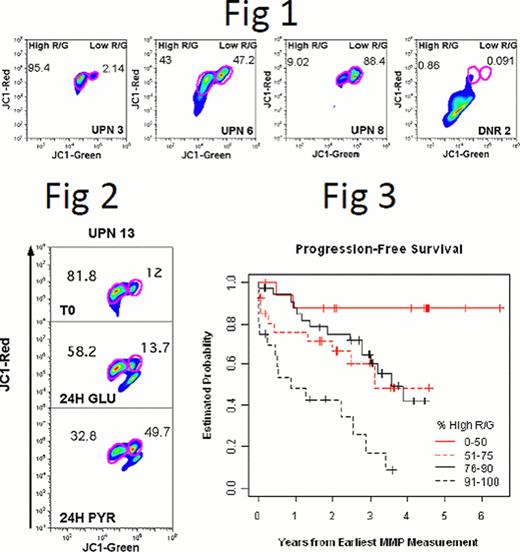Abstract
Abstract 2482
Despite the advent of prognostic factors such as cytogenetics and IGH mutational status, the natural history of chronic lymphocytic leukemia (CLL) remains heterogenous and difficult to predict in individual patients. We used the carbocyanine dye, JC-1, to investigate mitochondrial membrane potential in patients with untreated, predominantly early stage CLL. We found that JC-1 staining separated CD5+/CD19+ CLL cells into two discrete populations, Low Red (R)/Green (G) and High R/G, which mainly differed with regard to JC-1 green fluorescence (530 nm) in all patients (Fig. 1). In evaluating CLL patients, we found substantial variation in the proportion of cells in the two populations, with a range of 1.1% to 96.7% (median=79.9%) in the High R/G population. CD19+ B-cells from normal individuals typically had few cells with high JC-1 red fluorescence and had a JC-1 staining pattern that was distinct from CLL patients. Electron microscopy revealed disorganized mitochondrial christae, particularly in patients with elevated High R/G cell populations, compared with mononuclear cells from normal donors. Consistent with the morphologic disorganization, we found that the two populations of CLL cells had differential survival in culture with pyruvate and glucose as primary energy sources; cells in the High R/G population had inferior survival (p=0.016), while cells in the Low R/G population had equal survival in pyruvate compared with glucose (Fig. 2). This result indicates that the CLL clonal cell population can be subdivided into cells able to use oxidative phosphorylation and those dependent on aerobic glycolysis fro metabolic energy needs. Interestingly, patient samples with High R/G cell populations >90% had better cell survival in glucose-containing medium than samples derived from patients with < 75% High R/G cells (p=0.0085). We found that the mononuclear cells from patients with CLL expressed the M2 isoform of pyruvate kinase, which has been linked to the regulated utilization of aerobic glycolysis.
We assessed the outcome of 100 patients with untreated CLL with more than 1 month of follow up (median 36 months) after measuring the proportion of cells in the mononuclear fraction of the peripheral blood with in the High R/G population. The clinical characteristics of the patients at the time of JC-1 staining are characteristic of patients with early stage, untreated CLL. The population was divided into approximate quartiles based on the percentage of mononuclear cells in the High R/G population, and progression-free survival (PFS) was estimated within each quartile. Patients with 50% or fewer cells in the High R/G gate appeared to have an indolent natural history; an estimated 88% (95% CI: 73%, 99%) of the patients had no evidence of significant clinical progression at two years. In contrast, patients with more than 90% of cells in the gate with High R/G cells had rapid progression with an estimated PFS of 50% (95% CI: 31%–82%) at two years (Fig. 3). Patients with 50–90% cells in the High R/G gate had an intermediate disease course. There was strong evidence of a difference in survival distributions across the four JC-1 categories (log-rank p-value < 0.001). The percentage of cells in the High R/G gate provided prognostic information that was independent of good risk or poor risk cytogenetic changes.
In summary, we found that the clonal, neoplastic cells in patients with CLL comprise discrete populations separated on their metabolic dependence on aerobic glycolysis and aerobic glycolysis. We also show that the percentage of cells utilizing glycolysis has a significant adverse impact on the natural history of patients with CLL. Aerobic glycolysis, the so-called Warburg effect, is a common and incompletely understood aspect of cancer biology. These data tie the acquisition of aerobic glycolysis to more aggressive cancer biology, identify an important new prognostic measure for CLL and could lead to the development of therapies that target metabolic differences in cancer cells.
No relevant conflicts of interest to declare.
Author notes
Asterisk with author names denotes non-ASH members.


This feature is available to Subscribers Only
Sign In or Create an Account Close Modal